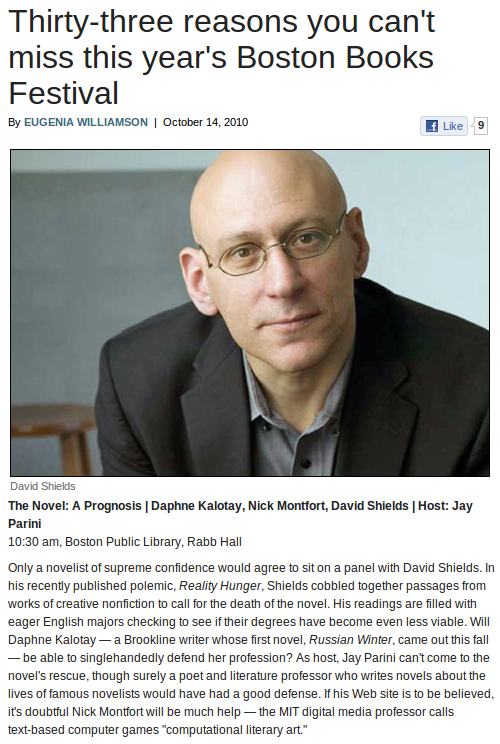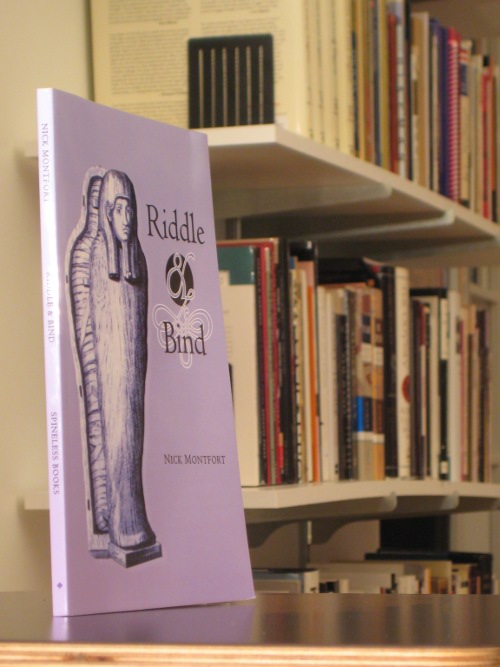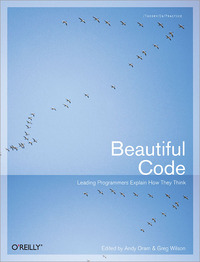I was a sort of “international observer” at the latest ELMCIP Seminar in Bergen, Norway. ELCMIP is a European project, funded by HERA, which looks at the ways electronic literature communities function and foster creativity. On the first day of the seminar (Monday, September 20) I presented about the IF community, supplementing that evening’s screening of Get Lamp at the Landmark Cafe. I offered some thoughts, summarized here, for those working in other types of electronic literature practices.
By “interactive fiction” (often abbreviated “IF”), I mean pretty much exactly what you will find if you Google for the term and starting looking through the first several pages of results. In my dissertation, I defined interactive fiction as: “A form of text-accepting, text-generating computer program that narrates what is happening in a simulated world in reply to input from a user, or interactor. Interactive fiction can have literary qualities and qualities of a game.” In recent decades, people have used the term in different ways, but this is how the interactive fiction community understands IF today and has understood it for a while. This means that IF is not defined by a particular platform, the way that Flash games are, but that people do expect something to work like a “text adventure,” with the simulation of space and objects and natural-language-like input, to be considered IF. Members of the interactive fiction community may find chatterbots, story generators, hypertext fiction, point-and-click graphical games, and other things very interesting, but these productions would not have a place in the annual Interactive Fiction Competition, for instance, because they aren’t interactive fiction.
I have to note at this point that I can’t offer any proper sort of study of the interactive fiction community, as I am not an anthropologist by training (or pretension) and I don’t understand the workings of community in the way that people with a better background would. What I can offer, as a member of this community, are some notes about my experiences and some pointers to ways I have seen the community working together. My hope is that may notes may be of some use in generating ideas about e-lit community or for someone undertaking a systematic study.
Also, I’ll explain at this point that what I and others call “the IF community” is not the only IF community, even for English-language work. One other community is that of authors and players of ADRIFT games. ADRIFT (Adventure Development & Runner – Interactive Fiction Toolkit) is an easy-to-use shareware system for IF development. Another locus of interactive fiction practice and playing is “adult interactive fiction” or AIF, which prominently depicts sexual activity. The AIF community has its own annual awards, the Erins, which are analogous to the IF community’s XYZZY Awards (discussed later). Beyond these communities, there are IF communities, or at least IF activity that involved several people and that I know about, in Spanish, German, Italian, French, and Russian language communities.
An important early resource for the IF community was the IF Archive, originally hosted in Germany thanks to Volker Blasius. The archive was announced on November 24, 1992 and is mirrored today on sites throughout the world, with the main site being ifarchive.org. The archive was originally accessed only by anonymous FTP and can still be reached by that method today, although there is a simple Web interface at the main site and a searchable interface at Baf’s Guide to the IF Archive. The “archive” is not a repository for an organizations old, inactive files; it a system for publishing and sharing new work, including the games for each year’s IF Competition.
The IF community communicated for many years on two USENET newsgroups – and some in the community still read these newsgroups. rec.arts.int-fiction and rec.games.int-fiction were not originally devoted to what we now call IF, but those discussions came to predominate. The “arts” and “games” groups do not argue for different perspectives on interactive fiction; they are simply for discussion of making games (“arts”) and playing them (“games”).
A central institution in the IF community – perhaps the central one – is the annual IF Competition, which began in 1994. Now in its 16th year and run by Stephen Granade, “the Comp,” as it is called, showcases a wide variety of short games, some poorly written and/or poorly programmed and others quite exemplary. While winning the Comp or placing well in it is certainly desirable, anyone who enters the comp can be sure that dozens, if not hundreds, of people will play the game submitted. Many will even write review of it, since it is a tradition among the most enthusiastic members of the IF community to review all of the Comp games. Competitions are central to many popular communities of digital practice – the demoscene as well as creators of Flash games, homebrew 8-bit games, and graphical games. These comps or compos usually do not involve substantial rewards for winners or agonistic competition; instead, they provide an event (in person in the case of the demoscene, online in other cases) that focuses the interest and energy of the community.
Recent years have seen other IF events of different sorts, including “minicomps” with different themes and the “Speed IF” sessions in which several participants each write a themed or constrained game in two hours. Some of the community’s events highlight the different metaphors that are in play, ones that work across literary and gaming concepts. Although works of interactive fiction are conventionally called “games” and the people who interact with them are called “players,” the person who writes a game (almost always the same person who programs it) is an “author.” The online “Interactive Fiction Book Club,” founded in 2001, brought together those who had played a particular game for conversation modeled on conversation about books. In 2009, “Interactive Fiction Writing Month,” with some in-person events that took place mainly at CMU, made an obvious connection to National Novel Writing Month. The annual XYZZY Awards for interactive fiction, on the other hand, are styled after the Oscars. Although they are awarded by popular nominations and popular vote, they are named in the manner of Academy Awards and presented at an online event. Many IF community members even virtually dress up for the award ceremony.
The XYZZY awards take place on ifMUD, a simple text-based MUD that serves almost entirely as a chat room. That is, role-playing and puzzle-construction and -solving have little place there and RPG-style combat has none. The people on ifMUD do use some of the unique MUD-like facilities to support their communications, however, and they also program new capabilities into the MUD for that purpose. There is a bot, Alex, who parrots things that he has been taught, allowing people to query him for the definition of terms and acroymns. An “automeeter” keeps track of which pairs of people have met in person. People use another bot, Floyd, to play IF together on ifMUD, participating in “Club Floyd” sessions. People also ask for programming, design, and writing help, and sometimes even discuss theoretical or critical ideas. Much of the discussion is not directly focused on IF, but when one does want to discuss IF in real time, ifMUD is a great place to do so.
There are now local groups that meet in person to discuss and play interactive fiction. The one I know most about is the one I host in Cambridge, Massachusetts, The People’s Republic of Interactive Fiction, organized by Kevin Jackson-Mead. PR-IF meets monthly, and had a hotel room with snacks and talks, thanks mainly to Andrew Plotkin, at Penny Arcade Expo East. They have also produced a card with instructions for first-time IF players. I organized the first meeting of the PR-IF writers’ group, Grue Street. And two successful events have been held in which the public was invited to play interactive fiction together: the early MIT version of Zork, in the first case, and Admiral Jota’s Comp-winning game Lost Pig in the second.
By now, most people who deal with electronic literature in some way seem inclined to accept that interactive fiction falls under this umbrella term. But even if some resist this, it’s hard to ignore that the community itself connects its meetings, events, roles, and practices to literary ones. Of course, simply importing the institutions of IF into other communities is unlikely to be helpful: Other e-lit communities may not need an FTP site, two USENET newsgroups, a MUD, and so on. But understanding how different structures, conventions, and tools have helped IF authors and players could have broader applicability. For instance, the IF Comp has worked to encourage the annual production of games, but it has also dominated IF production so that the best-known games are those short ones released for the IF Comp. (The community has responded with other comps and with projects to review other games, so the IF Comp is not too much of a victim of its own success.) Nevertheless, this situation can highlight the benefits and the dangers of a regular, central activity with its own format requirements. Considering the IF community may also point the way to other groups that are less obviously literary, but are creative communities of practice involved with computing.



 My new book – a book of poems entitled Riddle & Bind – has been published by
My new book – a book of poems entitled Riddle & Bind – has been published by 


